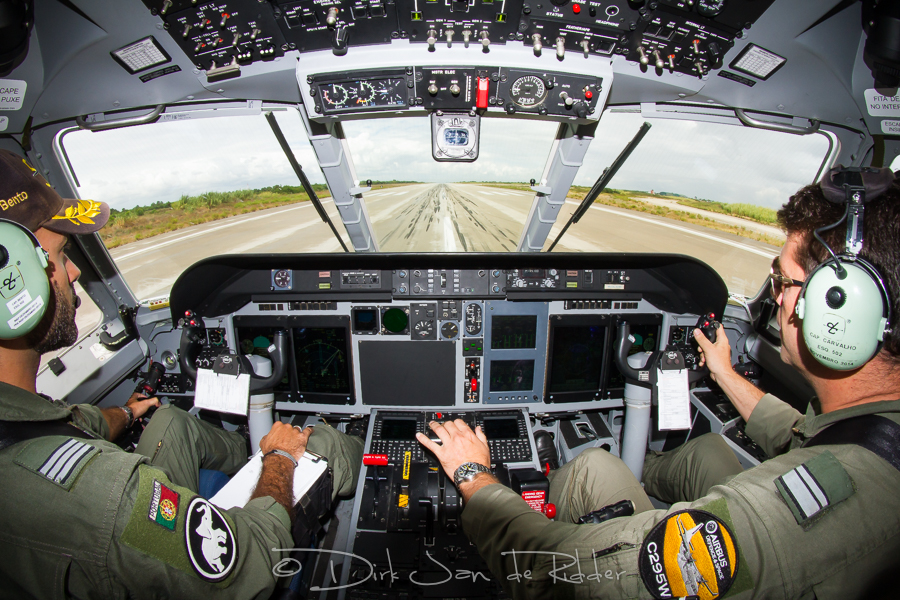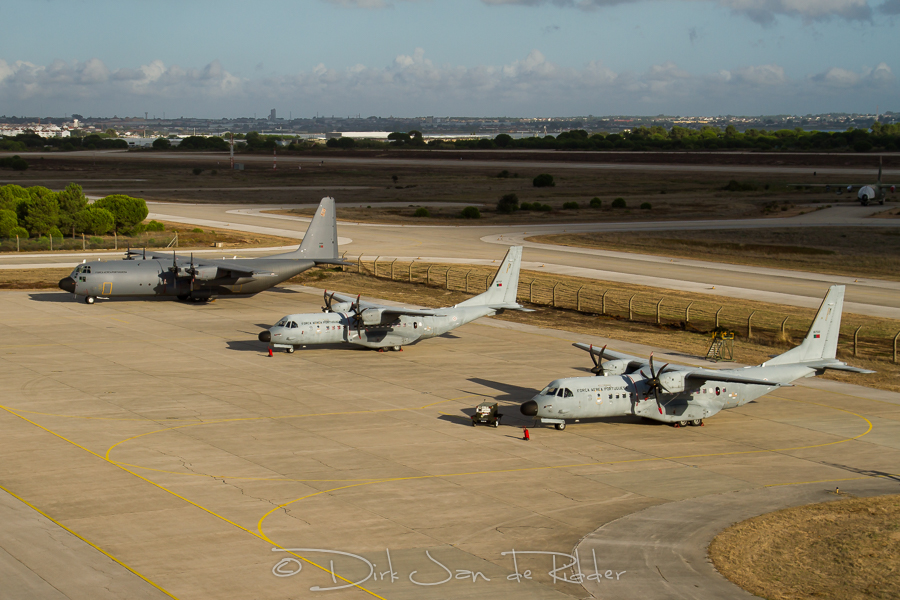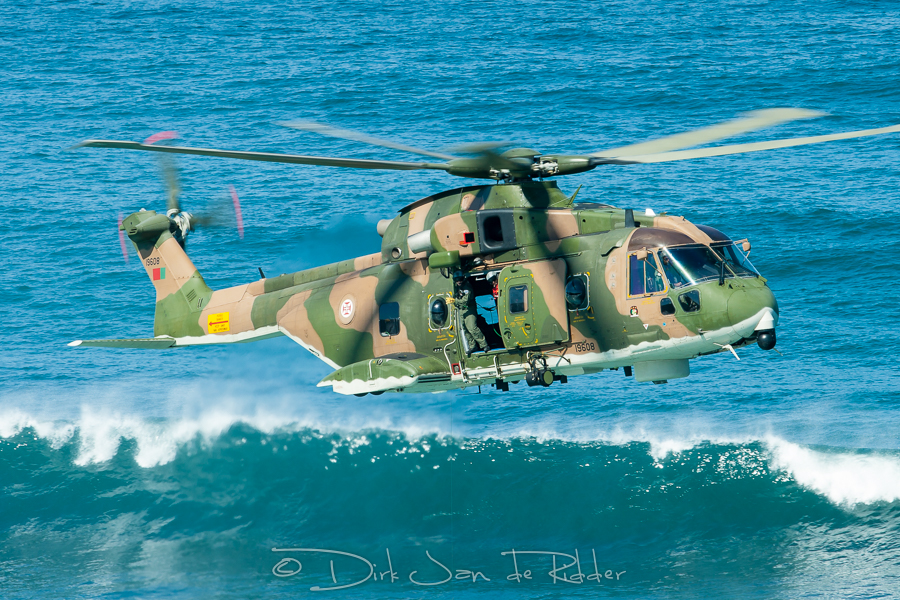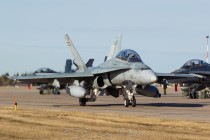Elephants to the rescue

The EADS CASA (currently Airbus Military) C-295s of Esquadra 502 ‘Elefantes’ are some of the Portuguese Air Force’s most sought-after air assets for a variety of missions and roles.
Being a member of 502 Squadron, whether flying or ground crew, is far from a nine-to-five job. Continuous two-week SAR deployments to the Azores or Madeira, daily 24-hour alert standbys at Montijo as well as day and night training flights add up to a busy work schedule. It is not uncommon for a pilot to leave the base on Friday afternoon for a regular weekend, then to be called in the evening to fly spare parts to the Azores or Madeira the next day. On weekdays often only a small handful of pilots are present in the squadron building, with the others flying, on alert, deployed to Italy for FRONTEX (EU border patrol), away for training or having a day off after working during the weekend. Due to its missions, it is impossible for the whole squadron to ever be all together.
Esquadra 502 is commanded by lieutenant colonel Miguel Oliveira Bernardino. He joined the Portuguese Air Force in 1991 and he flew the C-212 Aviocar with Esquadra 401, 502 and 711. From 2004 he formed part of the armed forces’ general staff team that defined the requirements for the C-212 replacement and he evaluated the C-27J and C-295M, both on paper as well as in-flight. No pilot can probably explain better the differences between the C-212 and the C-295M: “The C-212 was an aircraft bought 40 years ago. It is not comparable. It was a good aircraft in that time and for that mission, but to go to the Azores we couldn’t take any persons on board and we had to refuel at Porto Santo. Now we easily take 40 people as well as cargo and fly much further. We now have up to 1000 nautical miles of range with one hour on-station for SAR or ISR missions. The C-212s range was about 350 nautical miles and we didn’t have the radar, direction finding [equipment] or communication with the boats that we have today.”
He continues about the evaluation process: “The two aircraft met all our requirements. They are similar, but also very different. The C-27J is a typical military aircraft, like a small C-130 with very strong engines and all the wires and pipes visible [in the cargo compartment]. It is better, for example, for missions in Iraq, but it does not have any windows and it is not the most comfortable space for surveillance, personnel and VIP transport. The C-295 is less powerful, but very well tailored for this type of missions. Because the two aircraft complied with the requirements, the selection of the C-295 was not an operational choice, but it was based on our budget for the acquisition as well as 30 years of full in-service support.”

The squadron operates the C-295 in two variants. Seven C-295M aircraft are purely used for tactical transport. The remaining five aircraft are C-295MP maritime patrol aircraft. The C-295 takes a large amount of ‘unnecessary’ workload off the C-130 and P-3 fleet by filling the gap between the C-212 and those two aircraft. A C-295M burns about the same amount of fuel in two hours as a C-130 or P-3 does in one hour and it requires less maintenance, thus making it more reliable and a lot cheaper to operate.
According to lieutenant colonel Oliveira Bernardino however, the C-295 cannot completely replace either the C-130 or P-3, not even with the anti-submarine warfare equipment offered by Airbus Military: “No aircraft can replace the P-3 [in terms of range], not even the P-8. A lot of countries buy the P-3 second-hand or third-hand and try to extend its operational lifespan. We have a very big area of responsibility, the second largest after Canada, and for extreme long-range SAR you still need the P-3. There is space for two aircraft, one for patrol and another for surveillance. I think countries such as Australia and New Zealand are thinking about that too.”
”For patrol, I don’t know any aircraft like the P-3. You can employ the P-3 when you need it for extreme long range and keep it on the ground for daily missions up to 1000 nautical miles by using the C-295M or a similar aircraft. For the C-130 it is the same. The Portuguese Air Force didn’t really have a medium transport capability before the C-295 arrived. If you needed to transport 1 ton [of cargo], the C-212 couldn’t do it and you had to employ the C-130. At this moment we can perform 60 to 70 percent of the C-130’s missions. If you need to deploy 30 or 40 people, you can use the C-295M. For transporting a larger amount of persons or more than five tons of cargo directly to a place like Iraq, you must employ the C-130.”
Maritime patrol missions are flown with the C-295MP and a minimum crew size of five, consisting of a pilot in command, co-pilot, tactical coordinator, systems operator and cabin operator. The squadron itself prefers to name this role surveillance or ISR (Intelligence, Surveillance and Reconnaissance), probably to distinguish it from the maritime patrol mission carried out by the P-3 Orion which has an attack capability.
The C-295MP can easily be distinguished from the C-295M by the electro-optical turret under its nose and the ELTA 2022 surveillance radar below the cockpit, the same as found in the P-3 Orion, capable of scanning 200 nautical miles and up to 1000 targets at a time. The port wing contains a search light. This is not normally used, because by doing that the target will realize that he is being investigated. The MPAs are busy enough with local surveillance flights and FRONTEX missions, so they are based at Montijo, and not normally used for SAR. The C-212 used to have a search light and the Portuguese therefore requested it for the C-295, but the imagery provided by the electro-optical and infrared sensor has proven to be more than sufficient. The MPA is further equipped with a side-looking radar on each side of the cabin and three bubble windows for observers.

In 2014, for a period of four months, the squadron deployed a C-295MP to Naval Air Station Sigonella in Italy and Malaga in Spain as a contribution to Operations Aeneas, Hermes and Indalo. The main mission of these operations, which are managed by FRONTEX (the European Union’s border control agency), is to monitor the flow of illegal migration and smuggling from Africa to Europe. Between 2010 and 2013 the Portuguese Air Force already conducted 274 missions for FRONTEX, comprising about 1400 flying hours. In 2014, a total of 78 missions, comprising 420 flying hours, were flown for FRONTEX. One aircraft and 18 personnel were deployed, rotating every two weeks. An average week would see the detection of around four targets of interest.
Major Carvalho, the squadron’s operations officer, explains: “For us the FRONTEX mission has been a very good operation since 2010. It enabled us to develop our tactical and flight procedures and I think FRONTEX is also satisfied, because they are always trying to convince us to come back. Our aircraft has a medium to long range. We can go 800 nautical miles and stay in the operations area for about two to three hours. We can leave from Sicily and go almost to Egypt. That is what they need.”
Over the last ten years the Portuguese Air Force has made an incredible leap forward in its medical evacuation and search and rescue capability by replacing the C-212 Aviocar and SA330 Puma with the C-295M and AW101 Merlin. The Merlin’s range of up to 350 nautical miles enables it to cover a much bigger area and has thus triggered an increase in the amount of SAR sorties for the C-295M as well. Both types are on alert 24 hours per day, 7 days per week at three locations: Lajes (Azores), Montijo and Porto Santo (near Madeira). Lajes tends to get the most alert calls, due to tropical storms and its position astride major shipping lanes between Europe and the Americas.
The C-295M has flown some 190 medevac/SAR missions over the first three quarters of 2014 and more than 850 missions since it entered service. Some days comprise up to two or three sorties. Missions regularly start around midnight and could end up to nine hours later. In the SAR role, the aircraft is equipped with an MA-1 SAR kit, containing two 7-person dinghies and two survival packs. The kit is secured on the cargo ramp and dropped from low altitude. It is also among the standard equipment during FRONTEX missions. In 2014 during a FRONTEX deployment, they were fully prepared to drop a SAR kit for a boat that was sinking, but when they arrived at the operations zone Italian coast guard boats had already come to the rescue. It would have been the first time for the SAR kit to be dropped by the C-295M in a real emergency.

The cooperation between 751 Squadron -flying the EH101 Merlin- and 502 Squadron is very close during long-range SAR missions. Lieutenant colonel Oliveira Bernardino: “We have a very good relation with 751 Squadron. It dates back to a mixed squadron we had, Esquadra 711 in the Azores. In that squadron we had four crews flying the SA330 [Puma] and four crews flying the C-212. We tried to cooperate as we do now, although the C-212 didn’t have the capabilities, but the spirit and the concept already existed in that time. Our main purpose then was to be there in case the Puma went down into the ocean. Today, on missions over 100 nautical missions or if the helicopter commander asks for support, we go in front of them to make all the weather calculations, communications relay and give the last position [of the ship] to the helicopter.”
”We do all the briefings to the boat crew about security measures, the heading and speed they should maintain, the best area for the recovery. We feel that with this preparation, the crew of the boat are better prepared and with less adrenaline. If they have questions, we have half an hour to give them the comfort and confidence that they are prepared for the recovery.” During long-range missions of up to 350 miles off shore, the Merlin crew sometimes only has ten minutes to perform the rescue, so a perfect cooperation between the two crews and preparation of the boat crew can mean the difference between success and failure of a mission.
A mission isn’t over for the C-295M crew as soon as the Merlin recovers a person. On the way back they often escort the helicopter, as lieutenant colonel Oliveira Bernardino explains: “Depending on the conditions and the distance we stay with the helicopter until 100 nautical miles [off the coast]. If something happens to the Merlin, we can launch the SAR kit. If the intention is to transport the person from the helicopter to the C-295, we land and prepare the aircraft to receive the recovered person. This happens in several situations, for example when the helicopter is low on fuel. In extreme long-range missions to the north-west of the Azores, the Merlin must refuel at Flores before and after the mission. The time it takes us to go from Flores to Ponta Delgada, the main island in the Azores, is a lot shorter, so the patient, the doctors and their equipment then come with the C-295. Our aircraft is bigger, it is faster and it offers better conditions for the medical team to do their job.”
While countries such as Canada are looking for new search and rescue support aircraft and Airbus Military is offering the C-295 MPA to New Zealand and even the United Kingdom, the Portuguese Air Force may well have set the standards for how other countries could fulfil their maritime ambitions and obligations at reasonable costs.
A full report appeared in several magazines, including in Global Aviator:






Comments are closed.